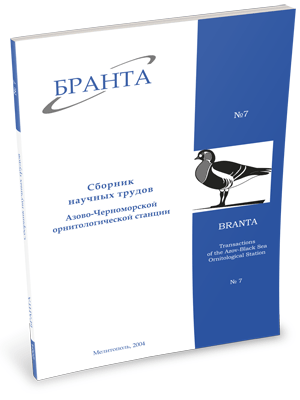
Transactions
of the Azov-Black Sea Ornithological Station



Dynamics of species composition and numbers of Ciconiiformes birds in the north near Azov area (1988-2004).
Koshelev A.I., Koshelev V.A., Peresad’ko L.V.
The paper presents the results of studying colonies and number dynamics of herons in the north near Azov area for 1988-2000. There are 9 species of Ardeidae in the region. Of them 8 species breed, and another Cattle Egret is a rare bird o f passage. Six species rnnter in the region. Total numbers of herons for a breeding period in wet seasons reach 3,860-4200 pairs, while in dry years these numbers dropped to 2,400 - 2,500 pairs. Twenty-four locations o f colonies and settlements of Ciconiiformes are found in the region, and 75% o f them are mixed. Large stable perennial settlements that consist of 2-26 colonies develop in reed plavni of upper Molochnyy Liman, in arboreal-shrubby vegetation of islands Bol'shiye Kuchugury and Malye Сuchugury, on Bol'shoy Islands of Obitochnyy Bay, and in wet years in reed plavni of middle Molochnaya River. Small colonies of arboreal and reed types are not constant, but dynamic in time and space. Among breeding species Grey Heron and Great White Egret dominate; their numbers in three settlements for various years were 500-1,500 and 200-450 pairs relatively. In wet years there usually develop shallow pools in which birds forage, and numbers of small species of herons increase while in dry years their numbers depressed. According to a type of the water body and habitat herons form colonies of different types: arboreal, reed and terrestrial. The type of breeding (single-territorial, in groups or colonial) reflexes flexible strategy of birds and is determined by ecological conditions of the season. Colonies of reed type dominate (60%). They differ from arboreal colonies by their short life and every year dislocation within one water body or on neighboring bodies. Depending on ecological conditions birds can both change location of the colony, and also its type from reed to arboreal or terrestrial and vise versa either during a season or in different years. Average size o f a mixed colony is 33.3-116.3 nests in different years, monospecies colonies contain 35-65 pairs.
Spatial pattern of colonies of reed type is simpler in comparison with that of tree type. The stratification in a nest location is low or absent, the horizontal pattern is determined by characteristics and mosaic of reedbeds. Nests of one species are mainly distributed in compact groups that isolated from analogical nest groups of other heron species. Grey Heron and Great White Egret are the most plastic species in choosing breeding places. They are high-tolerated to disturbance. Prohibition to shoot herons, development of the net of natural reserve areas provided restoration o f their numbers in the south of Ukraine including the north near Azov area and favour further increase in particular for large piscivorous species. Discovering and protection o f new colonies of Ciconiiformes and places of their mass concentration in post-breeding period will contribute to their successful existence.
Read the paper in a PDF file